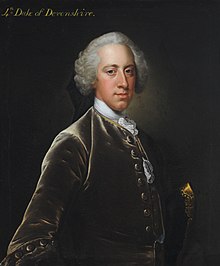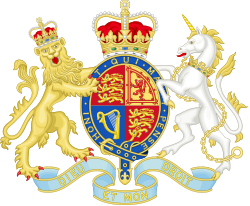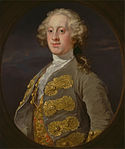William Cavendish, 4. Duke of Devonshire



William Cavendish, 4. Duke of Devonshire (* 8. Mai 1720; † 2. Oktober 1764 in Spa) war ein britischer Staatsmann der Whig-Partei, der schließlich nomineller Premierminister wurde.
Leben
William Cavendish war ein Sohn des William Cavendish, 3. Duke of Devonshire, und dessen Gemahlin Catherine Hoskins. Als Heir apparent seines Vaters führte er von 1729 bis 1755 den Höflichkeitstitel Marquess of Hartington.
Von 1741 bis 1747 war er als Knight of the Shire für Derbyshire Mitglied des House of Commons. 1751 wurde ihm aufgrund eines besonderen königlichen Beschlusses (Writ of Acceleration) der Titel eines Baron Cavendish of Hardwick, ein nachgeordneter Titel seines Vaters, übertragen. Er schied dadurch aus dem House of Commons aus und erhielt einen Sitz im House of Lords. Vom 2. April 1755 bis zum 3. Januar 1757 war Cavendish Lord Lieutenant of Ireland. Beim Tod seines Vaters erbte er 1755 dessen übrige Adelstitel als 4. Duke of Devonshire. 1756 wurde er zum Knight Companion des Hosenbandordens und zum Schatzkanzler ernannt. Diese Funktion hatte er bis zum Mai 1757 in einer Regierung inne, die de facto von William Pitt dem Älteren geführt wurde. Die meisten Historiker sehen Cavendish in diesem Zeitraum als Premierminister an.
Der Duke engagierte den Landschaftsgärtner Capability Brown, den Garten und den Park von Chatsworth House, seinem Hauptwohnsitz, zu gestalten.
Familie und Nachkommen
Er war mit Lady Charlotte Boyle (1731–1754) verheiratet, Tochter und Erbin von Richard Boyle, 3. Earl of Burlington. Sie war eine bekannte Architektin und Kunstsammlerin. Durch sie erbten die Devonshires Chiswick House und Burlington House in London, Bolton Abbey und Londesborough Hall in Yorkshire und Lismore Castle in der Grafschaft Waterford in Irland.
Aus der Ehe stammten folgende Kinder:
- William Cavendish, 5. Duke of Devonshire (1748–1811)
- Lady Dorothy Cavendish (1750–1794) ⚭ 1766 William Henry Cavendish-Bentinck, 3. Duke of Portland
- Lord Richard Cavendish (1751–1781)
- George Augustus Henry Cavendish, 1. Earl of Burlington (1754–1834)
Literatur
- Dick Leonard: William Cavendish, fourth Duke of Devonshire: "I have no motive but the King's service". In: ders.: British Prime Ministers from Walpole to Salisbury. The 18th and 19th centuries, Bd. 1, Routledge, London 2021, ISBN 978-0-367-46911-5, S. 51–55.
Weblinks
- William Cavendish, 4th Duke of Devonshire auf thepeerage.com, abgerufen am 15. September 2016.
| Vorgänger | Amt | Nachfolger |
|---|---|---|
| William Cavendish | Baron Cavendish of Hardwick (durch Writ of Acceleration) 1751–1764 | William Cavendish |
| William Cavendish | Duke of Devonshire 1755–1764 | William Cavendish |
| Lionel Sackville | Lord Lieutenant of Ireland 1755–1757 | John Russell |
| Charles FitzRoy | Lord Chamberlain 1757–1762 | George Spencer |
| Personendaten | |
|---|---|
| NAME | Cavendish, William, 4. Duke of Devonshire |
| ALTERNATIVNAMEN | Cavendish, William, 7. Baron Cavendish of Hardwick; Cavendish, William, Marquess of Hartington |
| KURZBESCHREIBUNG | britischer Politiker, Premierminister (1756–1757) |
| GEBURTSDATUM | 8. Mai 1720 |
| STERBEDATUM | 2. Oktober 1764 |
| STERBEORT | Spa |
Auf dieser Seite verwendete Medien
Autor/Urheber: Sodacan, Lizenz: CC BY-SA 3.0
Royal Coat of Arms of the United Kingdom of Great Britain and Northern Ireland in the style used by the Government of Queen Elizabeth II from 1952 to 2022 (as used in all places except Scotland).
| “ | Quarterly, First and Fourth Gules three lions passant guardant in pale Or armed and langued Azure (for England), Second quarter Or a lion rampant within a double tressure flory counter-flory Gules (for Scotland), Third quarter Azure a harp Or stringed Argent (for Ireland), the whole surrounded by the Garter; for a Crest, the imperial crown Proper; for Supporters, dexter a lion rampant guardant Or crowned as the Crest, sinister a unicorn Argent armed, crined and unguled Proper, gorged with a coronet Or composed of crosses patée and fleurs de lys a chain affixed thereto passing between the forelegs and reflexed over the back also Or; Motto 'Dieu et mon Droit’ ('God and my Right') below the shield. | ” |
- PINCHES, J.H & R.V., The Royal Heraldry of England, 1974, Heraldry Today.
Autor/Urheber: Rs-nourse, Lizenz: CC BY-SA 4.0
Coat of arms of William Cavendish, 4th Duke of Devonshire, KG, PC



